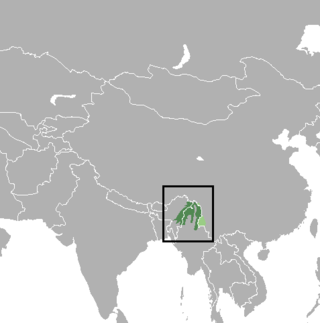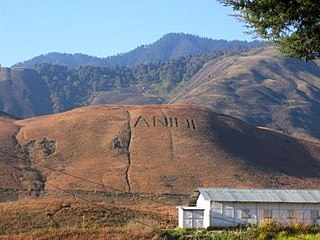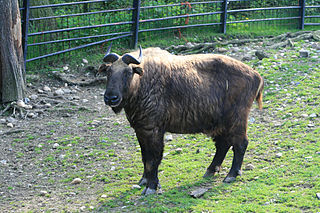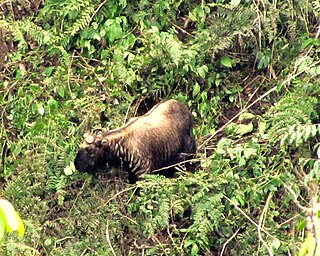
The subfamily Caprinae, also sometimes referred to as the tribe Caprini, is part of the ruminant family Bovidae, and consists of mostly medium-sized bovids. A member of this subfamily is called a caprine.

The mountain goat, also known as the Rocky Mountain goat, is a cloven-footed mammal that is endemic to the remote and rugged mountainous areas of western North America. A subalpine to truly alpine species, it is a sure-footed climber commonly seen on sheer rock faces, near-vertical cliffs and icy passages. Mountain goats generally avoid venturing down into lower elevations—except during seasonal food shortages or during particularly bad weather—as the extreme elevation which they inhabit is their primary defense against predators such as black and brown bears, pumas and wolves.

Dibang Valley (Pron:/dɪˈbæŋ/) is a district of Arunachal Pradesh named after the Dibang River or the Talon as the Mishmis call it. It is the least populated district in India and has an area of 9,129 square kilometres (3,525 sq mi).

The leaf muntjac, leaf deer or Putao muntjac is a small species of muntjac. It was documented in 1997 by biologist Alan Rabinowitz during his field study in the isolated Nogmung Township in Myanmar. Rabinowitz discovered the species by examining the small carcass of a deer that he initially believed was the juvenile of another species; however, it proved to be the carcass of an adult female. He managed to obtain specimens, from which DNA analysis revealed a new cervid species. Local hunters knew of the species and called it the leaf deer because its body could be completely wrapped by a single large leaf. It is found in Myanmar and India.

Anini is the headquarters of the Dibang Valley district in the state of Arunachal Pradesh in Northeast India. Anini was also the district headquarters of the undivided Dibang Valley district. Most of this location's population consists of the Idu Mishmi tribal people. Due to its remote location, Anini remains a small and underdeveloped town. However, it still has basic road and air links to the rest of India. The town is fully dependent on the nearest major settlement, Roing, which is in the Lower Dibang Valley District, for most commercial needs.

Walong is an administrative town and the headquarters of eponymous circle in the Anjaw district in eastern-most part of Arunachal Pradesh state in India. It also has a small cantonment of the Indian Army. Walong is on banks of Lohit River, which enters India 35 km north of Walong at India-China LAC at Kaho pass.

Myotragus is an extinct genus of goat-antelope in the tribe Caprini which lived on the Balearic Islands of Mallorca and Menorca in the western Mediterranean until its extinction around 4,500 years ago. The fossil record of Myotragus on the Balearic Islands extends over 5 million years back to the early Pliocene on Mallorca, where it presumably arrived after the evaporation of the Mediterranean Sea during the Messinian Salinity Crisis.

Anjaw District (Pron:/ˈændʒɔ:/) is an administrative district in the state of Arunachal Pradesh in north-east India. It was created district in 2004, by splitting off from the Lohit district under the Arunachal Pradesh Re-organization of Districts Amendment Act. The district borders China on the north. Hawai, at an altitude of 1296 m above sea level, is the district headquarters, located on the banks of the Lohit River, a tributary of the Brahmaputra River. It is the easternmost district in India. The furthest villages towards the border with China are Dong, Walong, Kibithu and Kaho.

The Lower Dibang Valley district (Pron:/dɪˈbæŋ/) is an administrative district in the state of Arunachal Pradesh in northeastern India. It is the tenth least populous district in the country.

The Eastern Himalayan alpine shrub and meadows is a montane grasslands and shrublands ecoregion of Bhutan, China, India, Myanmar, and Nepal, which lies between the tree line and snow line in the eastern portion of the Himalaya Range.

The golden takin is a threatened subspecies of takin, native to the Qin Mountains in the south of China's Shaanxi province. There are four distinct subspecies of the Takin: Mishmi Takin, Sichuan Takin, Bhutan Takin/White's Takin, and Golden takin.

The Mishmi takin is an endangered goat-antelope native to India, Myanmar and the People's Republic of China. It is a subspecies of takin.

The Sichuan takin or Tibetan takin is a subspecies of takin (goat-antelope). Listed as a vulnerable species, the Sichuan takin is native to Tibet and the provinces of Sichuan, Gansu and Xinjiang in the People's Republic of China.

The Bhutan Takin is a vulnerable subspecies of Takin native to Bhutan, North Eastern India, Western part of China, and Tibet. The main threats to the Bhutan Takin are hunting and habitat loss.
Dihang-Dibang or Dehang-Debang is a biosphere reserve constituted in 1998. It is in the Indian state of Arunachal Pradesh. The Mouling National Park and the Dibang Wildlife Sanctuary are located fully or partly within this biosphere reserve. The reserve spreads over three districts: Dibang Valley, Upper Siang, and West Siang. It covers high mountains of Eastern Himalaya and Mishmi Hills. The elevation in the reserve ranges up to more than 5,000 metres (16,000 ft) above sea level. An important fact relating to this Biosphere reserve is that it has natural vegetation stretching in an unbroken sequence from the tropics to mountain tundra. The type of vegetation are found in this biosphere reserve can be grouped as 1. Sub-tropical broad leafed forests, 2. Sub tropical pine forest, 3. Temperate broad leafed forests, 4. Temperate conifer, 5. Sub-alpine woody shrub, 6. Alpine meadow( mountain Tundra), 7. Bamboo brakes, 8. Grassland. The habitat in Dihang-Dibang ranges from tropical wet evergreen in the river gorges to subtropical, temperate, alpine and permanent snow.

The Eastern Himalayan subalpine conifer forests is a temperate coniferous forests ecoregion which is found in the middle and upper elevations of the eastern Middle Himalayas, in western Nepal, Bhutan, northern Indian states including Arunachal Pradesh and Sikkim and adjacent Myanmar and China.

Motithang Takin Preserve, located in the Motithang district of Thimphu, Bhutan is a wildlife reserve area for Bhutan takin, the national animal of Bhutan. Originally a mini-zoo, it was converted into a preserve when it was discovered that the animals refrained from inhabiting the surrounding forest even when set free. The reason for declaring takin as a national animal of Bhutan on 25 November 2005 is attributed to a legend of the animal’s creation in Bhutan in the 15th century by Lama Drukpa Kunley.

The Dibang Wildlife Sanctuary is one of the eight wildlife sanctuaries of Arunachal Pradesh, India.

The Mishmi Hills are located at the northeastern tip of India, in northeastern Arunachal Pradesh. On the Chinese side, they form the southern parts of Nyingchi Prefecture in the Tibet Autonomous Region.

Arunachal Pradesh is primarily a hilly tract nestled in the foothills of the Himalayas in northeast India. It is spread over an area of 83,743 km2 (32,333 sq mi). 98% of the geographical area is land out of which 80% is forest cover; 2% is water. River systems in the region, including those from the higher Himalayas and Patkoi and Arakan Ranges, eventually drain into the Brahmaputra River.





















